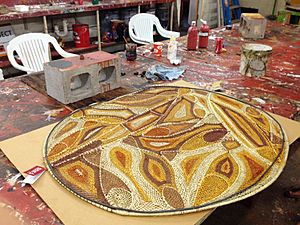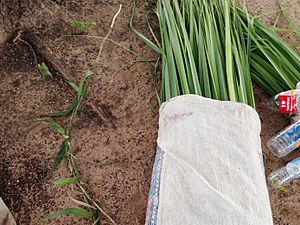Australian Aboriginal fibre sculpture facts for kids

Aboriginal fibre sculpture is a special type of art made by Aboriginal people using natural fibres. These objects have been made for a very long time. In the past, they were used for everyday tasks or for important ceremonies. Sometimes, the same object could be used for both.
It's tricky to call these items "art" or "craft" when thinking about old times. This is because Aboriginal people didn't always separate these ideas. But today, many of these fibre objects are seen as contemporary art. This includes old designs and new ones made for art shows. It can sometimes be hard to tell the difference between fibre sculpture and fibre craft. It often depends on how and where the object is shown.
Contents
Ancient Fibre Art
Long ago, Aboriginal communities created many amazing fibre sculptures. For example, the Rembarrnga people in Central Arnhem Land used fibre objects in their ceremonies. Dancers would hold animal figures made from paperbark or grass wrapped with string. This helped them pretend to be an important Ancestor.
Other figures, called Djondjon or Djawurn-djawurn, were shaped like humans. These were left behind at old campsites. A raised arm on a figure could show others which way the group had gone.
Fibre Art Becomes Famous
For a long time, Aboriginal fibre works were mostly seen as items for study or as crafts. But starting in the 1970s, things began to change. These works started to be recognized as fine art.
One big reason was that the Australian government began to support Aboriginal art centres. These centres helped artists sell their work and get feedback. They also helped artists show their art to more people. This encouraged artists to create new and exciting pieces.
Also, special art shows and awards began to feature fibre works. This helped people see them as fine art. Some important shows included Maningrida: The Language of Weaving (1989) and Twined Together (2005). Awards like the National Aboriginal & Torres Strait Islander Art Award (NATSIAA) also helped. Big art galleries, like the Museum of Contemporary Art Australia in Sydney, started to display fibre art as well.
Most Aboriginal fibre artists are women. They often learned skills like making fish traps, baskets, and mats. Today, many city-based Aboriginal artists are learning these old weaving skills. They sometimes use new materials or turn fibre art ideas into things like metal sculptures or glass art.
Fibre Sculpture in Different Communities
Rembarrnga Artists
An important step in modern Aboriginal fibre art happened in 1994. An artist named Lena Yarinkura and her husband Bob Burruwal started making new art. They used a traditional method of wrapping paperbark with string or bark fibres. This was like the old way of making djondjon animal figures for ceremonies.
Their first artwork, Family Drama (1994), won an award that year. Lena Yarinkura has continued to create many new fibre sculptures. She even uses fish trap weaving styles to show spirit beings. Most artists working in this style are supported by Maningrida Arts and Culture (MAC) in Maningrida.
Kuninjku Artists

The Kuninjku people in western and central Arnhem Land also developed their own fibre sculptures around the early 2000s. Their art often has flat shapes. They use vines like Flagellaria indica to make a strong frame. Then, they fill the frame with a knotted mesh made from pandanus fibre. This fibre is often colored with natural dyes.
Artist Marina Murdilnga is thought to have created this style. She based it on traditional fishing nets. Her first work in 2003 showed Yawkyawk, a female water spirit. This spirit and other animal figures are still popular subjects. Artists often make these works at Maningrida Arts and Culture (MAC) and Injalak Arts in Gunbalanya.
Central Desert Artists
In 1995, women's centres in the Central Desert region started. A person named Thisbe Purich taught the women how to make coiled baskets. They could use local grasses for the main part of the coil. They only needed to buy colored wool or raffia for wrapping.
This technique spread quickly. By 2001, artists like Kantjupayi Benson started making sculptures. She created an emu, a dog, and even "camp crockery" (dishes). In 2005, a large artwork called Tjanpi Grass Toyota won a major art award. Tjanpi Desert Weavers is a well-known art centre that works in this style.
See Also

